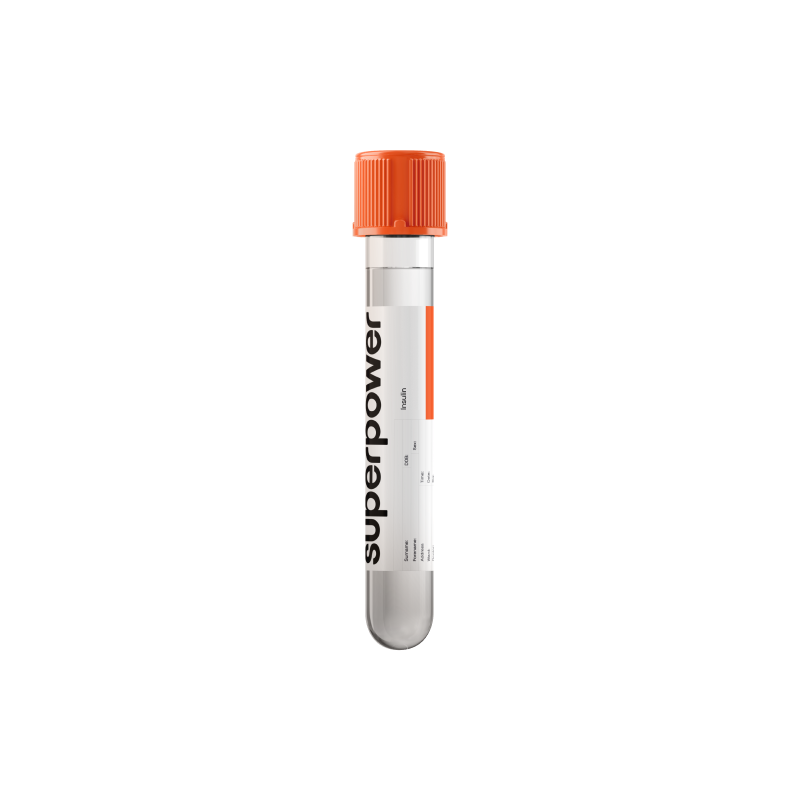See how your body manages blood sugar and energy balance. Insulin is the key hormone that regulates glucose use, fat storage, appetite, and long-term metabolic health.
Tracking your number provides an early signal of resistance or sensitivity so you can align food, movement, sleep, and stress with your biology.
Key Benefits
- Measure your insulin level to spot insulin resistance early.
- Flag rising diabetes risk before glucose or A1c move out of range.
- Explain stubborn weight gain and fatigue tied to high insulin and metabolic stress.
- Guide PCOS care by uncovering insulin drivers of irregular periods and ovulation issues.
- Protect heart and liver health by detecting insulin resistance linked to hypertension and fatty liver.
- Support pregnancy planning by identifying higher gestational diabetes risk from insulin resistance.
- Track progress on diet, exercise, or medications through trending fasting insulin levels.
- Best interpreted with fasting glucose, A1c, and your symptoms over time.
What is Insulin?
Insulin is the body’s key sugar‑regulating hormone, made and released by beta cells in the pancreas. These cells sit in small clusters called islets and secrete insulin into the bloodstream when they sense rising glucose after a meal. Insulin is a small protein (peptide hormone) first made as proinsulin and then split into active insulin plus C‑peptide before release. The producing cells live in the islets of Langerhans (pancreatic islets) and store insulin in tiny granules ready for rapid, pulsatile secretion.
Insulin’s main job is to signal the fed state so the body can use and store fuel. It moves glucose from blood into muscle and fat, tells the liver to store rather than make glucose, and promotes building while limiting breakdown (anabolism over catabolism). In scientific terms, it drives glycogen and fat synthesis, restrains gluconeogenesis and lipolysis, and supports protein synthesis via the insulin receptor and PI3K‑AKT signaling (receptor tyrosine kinase pathway). Measured in blood, insulin reflects how the pancreas and tissues are handling glucose and energy at a given time.
Why is Insulin important?
Insulin is the body’s master fuel–partitioning hormone. Made by pancreatic beta cells, it signals muscles and fat to take up glucose, tells the liver to store rather than make sugar, enables protein building, and coordinates lipid storage. Because of this, it influences energy, brain function, vascular health, reproductive hormones, and how we respond to meals.
On a fasting lab, insulin normally sits in a low, narrow range and rises after eating as it clears glucose from the bloodstream. In people with healthy glucose levels, optimal fasting values tend to be toward the low end of normal, reflecting good insulin sensitivity. During pregnancy, baseline insulin runs higher due to placental hormones.
When values are low, they can mean either excellent insulin sensitivity or inadequate insulin production. If too low for the body’s glucose load, blood sugar rises and ketones appear: thirst, frequent urination, weight loss, fatigue, and blurry vision are typical. In children and teens, this often signals type 1 diabetes; in adults it can reflect autoimmune beta‑cell failure (LADA) or pancreatic injury. In pregnancy, insufficient insulin leads to maternal hyperglycemia that can affect fetal growth.
When values are high, they usually reflect insulin resistance—pancreas working overtime to keep glucose normal. This often precedes high glucose by years and links to sleepiness after carb‑heavy meals, increasing waist, skin tags or darkened neck/underarms, fatty liver, high triglycerides, lower HDL, and higher blood pressure. Women may see ovarian androgen excess and irregular cycles (PCOS); men may notice reduced testosterone and erectile issues. Large swings can cause shakiness and hunger from reactive hypoglycemia.
Big picture: insulin sits at the crossroads of muscle, liver, fat, brain, and vascular systems. Its pattern over time predicts risks for type 2 diabetes, cardiovascular disease, kidney disease, and fatty liver, and it interacts with thyroid, cortisol, and growth hormone to shape long‑term metabolic health.
What Insights Will I Get?
Insulin measures the pancreas’s signal for storing and using fuel. It moves glucose into muscle and fat, restrains liver glucose output, and shifts metabolism toward building and storage (anabolic effects). Because of this, insulin status links to energy stability, body composition, blood pressure, lipids, vascular health, cognition, fertility, and immune signaling.
Low values usually reflect either low demand in an insulin‑sensitive state (especially when fasting) or inadequate beta‑cell secretion. When glucose is high at the same time, low insulin points to deficiency, causing hyperglycemia, dehydration, and ketone production (risk of ketoacidosis). In type 1 diabetes and late beta‑cell failure in type 2, insulin can be very low. In pregnancy and childhood, true low insulin with high glucose is concerning because physiologic demand is higher.
Being in range suggests matched supply and demand: adequate beta‑cell reserve, good insulin sensitivity, and stable fasting and post‑meal glucose. This supports efficient fuel use, less ectopic fat, and favorable cardiometabolic signaling. For fasting measurements with normal glucose, many consider “optimal” toward the lower end of normal.
High values usually reflect compensatory hypersecretion from insulin resistance in muscle, liver, and adipose tissue. This state promotes higher triglycerides, lower HDL, sodium retention and higher blood pressure, endothelial stress, inflammation, and, in ovaries, increased androgens with irregular cycles (features of PCOS). During puberty and pregnancy, higher insulin can be physiologic; persistent elevations outside these contexts suggest metabolic strain. High insulin with low glucose raises concern for endogenous overproduction (insulinoma) or medication effects.
Notes: Interpret with fasting status, timing after meals or glucose loads, and alongside glucose and C‑peptide. Renal impairment raises insulin by reducing clearance. Corticosteroids, insulin secretagogues, and some antipsychotics increase levels. Assays vary, and exogenous insulin may not be detected uniformly.



.svg)



.png)
.png)
.png)
.png)








